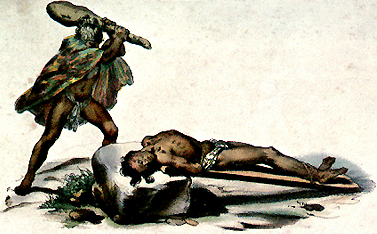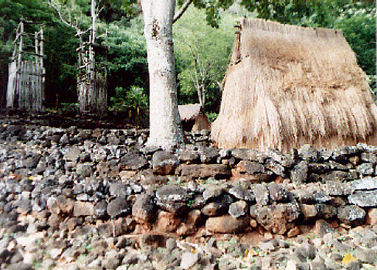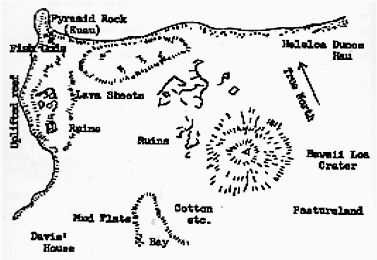Heiau: Native Hawaiian Temples
Hawai`i Resource Library
|
In the early 1900's, Bishop Museum anthropologist John Stokes began his lifelong mission of documenting the existing Heiau Temples) in the Hawaiian Islands. He found over 150 Heiau sites on the island of Hawai'i, about 70 on Moloka'i and several on the islands of Kaua'i, O'ahu and Kaho'olawe. His studies focused on drawing plans of the stone structures, describing in detail and taking photographs of his subjects. Based on his personal observations, interviews with Native Hawaiians living in the area and David Malo's clasic work on Hawai'i written in 1823 "Hawaiian Antiquities", Stokes theorized that the HAWAIIAN architects, Kahuna Kuhikuhipu'uone (priests who specialized in Heiau design and construction) focused on two basic types; the platform and the walled enclosure.
The walled Heiau
is the oldest type; its roots buried in the jungles of central America
and North Africa, spreading with the wind and sea currents to the
Pacific islands. These stone monuments to the Gods were built for
specific purposes usually to celebrate or insure favor from the spirit
world. Human sacrifice was performed at all Heiau, but walled Heiau were
used mainly for human sacrifices. All Heiau dedicated to the God Ku (war
and defense) used human sacrifice as a principle offering to appease the
God. There are many intermediate forms and combination of the two. We
will describe one structure of each type.
Mo'okini Heiau at Pu'uepa, North Kohala District, on the Big Island of Hawai'i, the birthplace of Kamehameha I, built in A.D. 460, represents a classic example of the walled type. A large stone called Pohakuhanauali'i, the afterbirth of Kamehamhema is located near this heiau.
Human sacrifice was routinely practiced here, taking the mana (spiritual strength) from the victim to insure victory in war. The captives, usually chiefs captured in battle, would be hung upside down on wooden racks, where the their sweat would be collected to anoint the Kahuna (priests). Next the victims would have their bones and flesh pounded to soften the meat. The victims would then be disembowled and either cooked or eaten raw by the Kahuna and the Ali'i (Chiefs) seeking the mana from the captives. According to legend, at Mo'okini, the last human sacrifices were made in the late 1870's.
Pu'ukohola Heiau at Kawaihae, Kohala District on the Big Island of Hawai'i overlooking the sea, built by The Great MoiKamehameha I in 1791, is an example of the platform type.
Upon the completion of the Heiau, Kamehameha invited his rival, Chief Keoua, from the south end of the island at Ka'u, to "celebrate" the new temple to their mutual guardian God of War, Ku. Keoua traveled by canoe from Ka'u to Kona where he bade farewell to his Ohana (family) there. He had a sense of pending doom. Keoua then paddled with some of his men to Kawaihae. As he stepped ashore, he was run through with a spear. Keoua's body was taken up to the great Heiau, sacrificed and eaten by Kamehameha and his chiefs.
British explorer Vancouver lost three of his seamen to the human sacrificial at Puu-o-Mahuka Heiau in about 1795.
The noted Hawaiian Historian, S.M. Kamakau at Ka Moolelo o Na Kemehameha, Kuokoa, Nov. 16, 1867 stated: "The lands to the Kahunas (priests) were Waimea, Pupukea, Waiahole and Hakipu'u. These lands belong to the priests from ancient times down to that of Kahahana. In the time of Kahekili and Kalanikupule, these were given to their Kahunas and so also in the reign of Kamehameha I Pupukea belonged to the priests of Kua'ali'i (Kuali'i)". (see Sterling, 1978, Sites of O'ahu)
Very limited archeological study has been done on this Heiau. It was dedicated to the war God Ku. The site is aligned with the winter solstice and was used in conjunction with Ku temple worship on the Island of Kaua'i, 75 miles to the north west. The entire structure encloses an area of more than 120,000 square feet of rock paved flooring. Native Hawaiian practitioners continue to use this temple for religious purposes today.
Hale-o-lono was not designed for human sacrifice on a regular basis, however, at the beginning of the Makahiki, human offerings were made where a fish and a human were offered, the Kahuna plucking out the eyeball of both victims; then eating the eyeball's raw, would begin the celebrations and ensure good harvest and fishing in the coming year.
Puuhonua Lehua Heiau, Mokapu Peninsula, Kaneohe Marine Corps Air Base, Oahu: In the vicinity of Paohua, (See site 367, Ko'a) about 75 feet from the beach, the stones Ku and Hina were formerly located. They are said to have been removed some years ago by George Moa and thrown into the water. Shortly after this act, according to the Hawaiians, Moa became insane and died. Both Ku and Hina, Iying on the beach though covered at high tide, were pointed out by Kalani after some search. Pohaku hauau a Kuau (disappearing stone of Kuau) is a rock which can only occasionally be seen, just off Kuau (Pyramid Rock). The two small elevations southwest of Kuau are known as Keawanui and Keawaiki respectively......McAllister Arch. of Oahu
Site 367: 1) platform 33.5 feet by 17.5 feet, less than 1 foot high, edged with 1-food stones and sand-paved, many raugh lava stones scattered an north end; 2) platform, 17 feet by 3.3 feet, 1.3 feet high, edged with large stones, paved with small coral; 3) smooth, dark-colored Stone, known as Kanaloa protruding about 1 foot above paving; 4) smooth, light-colored stone, known as Kane, not so large as Kanaloa; 5) platfonn 8 feet square and 1 foot high on southwest corner of platform 1....McAllister Arch. of Oahu
BASIC TERMS
ai-kanaka: cannibalism: The bountiful lands and water of the Hawaiian islands sustained over 1,000,000 Native Hawaiians in the late 1700's. So plentiful was the harvest that every year, a celebration of games and feasting from November to February took place. No work or war was allowed. Usually, human sacrifice was made to the war God Ku. The victims were enemy ali'i (chiefs) taken prisoner in battle. By eating the flesh of such a person, the mana (strength, power and spirit) of that person was transferred to the victor by the act.
As first described by Cooke: "seeing a man with a small parcel fastened with a string to his fish-hook, Cooke asked what it was and was told it was human flesh.....Cooke was asked by a native if the white men ate the people they killed...and was told that if the sailors were killed on shore, they would be eaten....in offering human sacrifice it was the custom for the officiating priest to pluck out the left eye of the victim and make pretense of eating it....evidently the relic of some old cannibalistic rite...."
In 1779, when Cooke was killed, his heart was eaten by three children who happened to be on the beach at the time. By 1843, in his "History of the Sandwich Islands" the Rev. S. Dibble writes: "the practice was not common, and it is due to the Hawaiians to say that those few instances that did exist were looked upon by most of the people with horror and detestation". Dibble saw life through the white man's eyes and did not take the time to understand the meaning of the act.
hale-o-papa: place in the Heiau where women of high rank could congregate.
heiau: temple
imu loa: oven underground used for human sacrifices
kahuna kuhikuhipu'uone: priests who specialized in Heiau design and construction.
kahuna: priest...a class unto itself...second only to the Ali'i yet powerful enough to influence politics and the general everyday activities of the Chiefs through prophecy. A priest would use the powers of:
kapu: prohibitions, law, keep out, forbid, stop what you are doing.violators punished by death
koko: blood
mana: supernatural power, spirt of those taken in the act of cannabilism
mu: agents of the priests (kahuna) who brought the sacrificial offerings to the temple (heiau)
nakuialua: bone breaker
pohaku: upright stone, symbol of an alter or place of worship
pu'uhonua: temple or city of refuge
uli: spirit of death
umi: strangle or choke, a method of killing law breakers (kapu) |
||
|
|
||
|
|
|
|
|
|
||
| History | Atlas | Culture | Language | Links |



 Puu-o-Mahuka
Heiau is located on the north ridge of Waimea Bay on the north shore
of the Island of O'ahu, at Pupukea-ahupua'a. This massive structure,
built on the ridge top overlooking Waimea Bay, is the largest Heiau on
O'ahu.
Puu-o-Mahuka
Heiau is located on the north ridge of Waimea Bay on the north shore
of the Island of O'ahu, at Pupukea-ahupua'a. This massive structure,
built on the ridge top overlooking Waimea Bay, is the largest Heiau on
O'ahu. Hale-o-Lono
Heiau, built around 1400 A.D., dedicated to the God of Agriculture,
Lono, is located in the lush Waimea Valley, on the north shore of the
Island of O'ahu, less than 1/8 of a mile from Puu-o-Mahuka Heiau.
Hale-o-Lono
Heiau, built around 1400 A.D., dedicated to the God of Agriculture,
Lono, is located in the lush Waimea Valley, on the north shore of the
Island of O'ahu, less than 1/8 of a mile from Puu-o-Mahuka Heiau. Kamakapele
confirms story re George Moa. Ku and Hina were visible in McAllister's
time, but since then the Navy dredging activities have changed
conformation of area and Ku and Hina are no longer visible, being in
deep water. (According to Kamakapele they still "live" because this is
so. ) Barrere, D. March 1, 1952
Kamakapele
confirms story re George Moa. Ku and Hina were visible in McAllister's
time, but since then the Navy dredging activities have changed
conformation of area and Ku and Hina are no longer visible, being in
deep water. (According to Kamakapele they still "live" because this is
so. ) Barrere, D. March 1, 1952